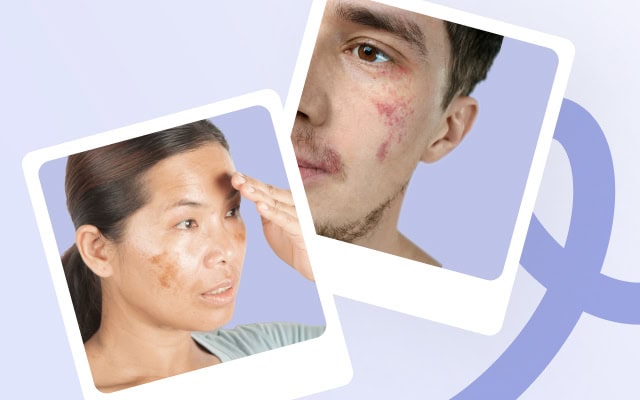How to get a vitiligo cream with an online consultation?
Dr. Eric Howell talks about the different vitiligo treatment creams and tells you how to secure an online prescription.
Table of Content:
Are there any vitiligo creams that are OTC? | How to get an online prescription? | Why Miiskin? | Best treatment creams | Oral medications | What else can you do? | FAQ
Our commitment to producing high-quality content:
The information presented in this article is based on scientific research and the professional advice of our Content Medical Reviewers, who are experts in the field of Dermatology. How we write our content →
In this article, Dr. Eric Howell, board-certified dermatologist who offers online consultations to patients via the Miiskin platform, talks about the newest and best treatments for vitiligo, including how these treatments work, and guides you on how to submit an online consultation via Miiskin.
What is vitiligo?
Vitiligo is a chronic skin condition characterized by the loss of pigmentation in patches of the skin. This occurs when melanocytes, the cells responsible for producing melanin, are destroyed or stop functioning. As a result, white patches of skin appear in various parts of the body.
Vitiligo can affect any area of the skin, but it is most commonly found on the face, hands, arms, feet, and around body openings like the mouth and eyes. The condition is not contagious or life-threatening, but it can have significant psychological and social impacts on those affected. Treatment options aim to restore skin color or even out skin tone and may include topical medications, phototherapy, and other therapies.
Are there any vitiligo creams that are sold over-the-counter (OTC)?
Dr. Howell says there are no over-the-counter creams that can treat vitiligo by restoring pigment. The creams that actually help repigment skin—such as topical corticosteroids, calcineurin inhibitors (tacrolimus, pimecrolimus), or Opzelura—are all prescription-only.
However, he also added that there are OTC products that can support vitiligo care:
- Broad-spectrum sunscreen (SPF 30+) to protect depigmented areas from sunburn and prevent contrast from getting worse.
- Moisturizers to reduce dryness and improve skin barrier health.
- Camouflage or concealer creams to even out skin tone for cosmetic purposes.
These can help manage appearance and protect skin, but they won’t reverse pigment loss. To get a vitiligo treatment cream, you’ll need to consult an online dermatologist.
How can I get an online prescription for a vitiligo cream?
You can have an online consultation with a board-certified dermatologist through Miiskin. Choose a dermatologist licensed in your state, answer the quick questionnaire and upload photos of your skin. In less than two days you will get your prescription.
Why choose Miiskin to get a prescription for a vitiligo cream?
With Miiskin, you can get a prescription for effective vitiligo treatments—like topical corticosteroids, tacrolimus, pimecrolimus, or ruxolitinib—without the need for an in-person visit. All consultations are handled by independent, board-certified dermatologists, so you know you’re getting expert care from your chosen skin specialist, not a random provider. The process is fast and convenient: you simply submit your information and photos online, and a dermatologist reviews your case—often in just minutes. Miiskin also gives you control over which pharmacy fills your prescription, so you can choose the best price and most convenient location. Plus, your privacy is protected through secure, HIPAA-compliant technology.
Secure, confidential, and reviewed by board-certified dermatologists.
What are the best treatment creams for vitiligo?
JAK inhibitor (Opzelura/ruxolitinib)
- Usage: Approved by the FDA for the treatment of nonsegmental vitiligo in patients aged 12 and older. Applied twice daily to the affected areas.
- Mechanism of action: Opzelura is a Janus kinase (JAK) inhibitor that works by blocking the activity of specific enzymes (JAK1 and JAK2) involved in the immune response that causes inflammation and destruction of melanocytes, the cells responsible for skin pigmentation.
- Effectiveness: Approximately 50% of users experience considerable repigmentation after one year. After two years 75% of users experience considerable repigmentation1.
- Side effects: Common side effects include application-site acne, redness, and itchiness. It comes with a black box warning due to potential serious side effects observed with oral JAK inhibitors2.
Topical corticosteroid creams (clobetasol, betamethasone) for vitiligo
- Usage: Used intermittently to control inflammation and promote re-pigmentation.
- Mechanism of action: These medications suppress the immune response and reduce inflammation in the skin. Corticosteroids inhibit the production of substances that trigger inflammatory and immune responses, thereby preventing the immune system from attacking melanocytes3.
- Effectiveness: They are effective in controlling inflammation and promoting repigmentation but are often used intermittently to prevent side effects such as skin thinning4.
- Side Effects: Can cause skin atrophy, striae, and telangiectasias, especially when used on sensitive areas like the face5.
Topical calcineurin inhibitors (tacrolimus, pimecrolimus)
- Usage: Effective for sensitive areas such as the face, neck, and intertriginous regions. Preferred for patients who cannot use topical steroids.
- Mechanism of action: These drugs inhibit the activity of calcineurin, a protein that activates T-cells of the immune system. By inhibiting calcineurin, these medications reduce inflammation and the immune response that leads to the destruction of melanocytes.
- Effectiveness: Particularly useful for treating vitiligo in sensitive areas like the face and neck where corticosteroids might cause unwanted side effects.
- Side Effects: Generally safe but less effective than high-potency steroids for non-facial lesions6 7
What oral medications (tablets) can be used for vitiligo?
Oral corticosteroids (prednisone, dexamethasone)
- Usage: Used for rapidly progressing and extensive vitiligo to halt the spread of depigmentation.
- Mechanism of action: Similar to topical corticosteroids, oral corticosteroids reduce inflammation and suppress the immune system. They are often used in cases of rapidly progressing vitiligo to halt the spread of depigmentation.
- Effectiveness: They can be effective in stopping the progression of vitiligo, but due to significant side effects, they are not typically used for long-term repigmentation treatment.
- Side effects: Include weight gain, hypertension, increased blood glucose, and bone loss. Not typically used for long-term repigmentation8 9 .
Azathioprine
- Usage: Azathioprine may be considered for progressive, recalcitrant vitiligo. It is used to suppress the immune system to prevent further loss of pigment.
- Mechanism of Action: Azathioprine works by broadly suppressing the immune system to prevent it from attacking melanocytes, the cells responsible for skin pigmentation. It inhibits the synthesis of purines, which are necessary for the production of DNA and RNA in immune cells, thus reducing the proliferation and activity of T-cells and other immune cells involved in the autoimmune response10.
- Effectiveness: Used for more severe and recalcitrant cases of vitiligo, azathioprine can help control the progression of the disease11 12 .
- Side Effects: Azathioprine can have significant side effects including increased susceptibility to infections, liver toxicity, bone marrow suppression, gastrointestinal disturbances, and an increased risk of malignancies. These potential side effects require careful patient monitoring13.
Cyclosporine
- Usage: In some cases, cyclosporine may also be considered for progressive vitiligo14.
- Mechanism of action: Cyclosporine works by inhibiting calcineurin, a key enzyme in T-cell activation. By binding to the protein cyclophilin in lymphocytes, it prevents the activation of T-cells, thereby suppressing the immune response against melanocytes.
- Effectiveness: Cyclosporine is effective in reducing the immune response and controlling autoimmune diseases, but its use in vitiligo is less common and typically considered when other treatments have failed. Its effectiveness in vitiligo may vary, and it is often used in combination with other therapies.
- Side effects: it can cause significant side effects, including nephrotoxicity, hypertension, increased risk of infections, and an increased risk of malignancies15.
Methotrexate
- Usage: Methotrexate may also be considered for progressive, recalcitrant vitiligo.
- Mechanism of action: Methotrexate inhibits dihydrofolate reductase, an enzyme involved in the synthesis of nucleotides. This action interferes with DNA synthesis, repair, and cellular replication, particularly affecting rapidly dividing cells such as immune cells.
- Effectiveness: Methotrexate is effective in controlling autoimmune responses and inflammation. It can help in reducing the progression of vitiligo, although it is more commonly used for other autoimmune conditions. Its effectiveness in vitiligo may vary and is often used when other treatments are ineffective16 17 .
- Side effects: Methotrexate can have significant side effects, including liver toxicity, bone marrow suppression, gastrointestinal disturbances, and increased risk of infections. Patients require regular monitoring of liver function, blood counts, and overall health to manage these risks18.
Secure, confidential, and reviewed by board-certified dermatologists.
What else can you do to get rid of vitiligo?
Addressing vitiligo effectively can be a complex process, however, a multifaceted approach that includes prescription-strength vitiligo creams together with dermatology treatments at a local clinic can significantly improve your outcome.
NBUVB Therapy
Narrowband Ultraviolet B (NBUVB) therapy involves exposing the skin to a specific wavelength of ultraviolet light (311-313 nm). This light helps to stimulate melanocyte activity, which can promote the migration and proliferation of these pigment-producing cells in the skin. It also has an immunosuppressive effect, reducing the autoimmune response that leads to the destruction of melanocytes in vitiligo.
NBUVB therapy is particularly beneficial for patients with widespread or rapidly progressive vitiligo. It is usually administered in a clinical setting two to three times per week. The treatment can halt the progression of vitiligo and induce repigmentation in many patients. Home phototherapy units are also available for patients who need long-term treatment.
Studies have shown that NBUVB is effective in inducing repigmentation in a significant proportion of patients, with early initiation of therapy yielding better results. It is considered the first-line phototherapy option for vitiligo19.
Excimer laser
The excimer laser delivers targeted, high-intensity UVB light (308 nm) directly to the depigmented areas. This focused approach allows for higher doses of UVB to be applied to small, specific areas without exposing the surrounding skin.
Studies show that excimer laser therapy is used for patients with localized vitiligo, particularly for lesions on the face and other small areas. Treatments are typically administered once or twice a week until repigmentation is achieved. This therapy is effective in promoting repigmentation, with many patients seeing results after a few sessions. It is especially useful for patients who do not respond well to other treatments or have localized vitiligo20.
Skin grafting
Skin grafting involves transplanting healthy, pigmented skin from one area of the body to the depigmented areas. The grafts can be full-thickness or split-thickness, depending on the size and location of the vitiligo patches.
This surgical approach is considered for patients with stable vitiligo, where the depigmented areas are not changing. The procedure is typically performed in a surgical setting under local anesthesia.
Skin grafting can provide permanent repigmentation in the treated areas. However, the success rate varies, and there is a risk of complications such as graft rejection or infection.
Blister grafting
Blister grafting involves creating blisters on the pigmented skin using suction. The top layer of the blister (epidermis) is then transplanted to the depigmented areas.
This method is used for smaller vitiligo patches. It is less invasive than other grafting techniques and can be performed under local anesthesia.
Blister grafting has shown good results in promoting repigmentation, with fewer complications compared to other grafting methods. The main limitation is that it is suitable only for small areas of vitiligo.
Cellular grafting
Cellular grafting involves harvesting melanocytes and keratinocytes from the patient’s healthy skin, processing these cells, and then transplanting them to the depigmented areas. This technique aims to repopulate the vitiligo patches with pigment-producing cells.
Cellular grafting techniques, such as the melanocyte-keratinocyte transplantation procedure (MKTP), have shown superior results compared to traditional grafting methods. MKTP involves using non cultured epidermal cell suspensions to cover larger surface areas and provide a better color match, resulting in more natural repigmentation. The procedure has been refined and simplified, making it more accessible to clinicians without the need for specialized laboratory facilities. Additionally, combining cellular grafting with phototherapy and topical treatments like tacrolimus enhances and accelerates repigmentation, offering a promising first-line surgical therapy for stable vitiligo21.
Secure, confidential, and reviewed by board-certified dermatologists.
Frequently asked questions about vitiligo treatment
Can vitiligo be cured permanently?
According to Dr. Howell, vitiligo cannot be cured permanently. While various treatments can help restore skin color and manage the condition, there is currently no cure that completely eliminates vitiligo. The condition is chronic and may require ongoing management.
Can you stop vitiligo from spreading?
Dr. Howell says that it is definitely possible to stop or slow the spread of vitiligo with treatments such as corticosteroids, calcineurin inhibitors, and phototherapy. Early intervention and consistent treatment under the guidance of a dermatologist can help control the progression of the condition. Once vitiligo has been present for a period of two years or more, all treatments become much less effective so seeking treatment early is very important.
What is the best treatment for vitiligo?
Dr. Howell says the best treatment for vitiligo varies depending on the individual. Commonly effective treatments include topical corticosteroids, calcineurin inhibitors, and phototherapy. A dermatologist can recommend the most suitable treatment based on the extent and location of the vitiligo.
Which food should I avoid for vitiligo?
There is no specific food that must be universally avoided for vitiligo, but some suggest avoiding foods that may trigger inflammation or an immune response, such as citrus fruits, gluten, and dairy. However, these recommendations are not scientifically proven, and dietary changes should be discussed with a healthcare provider.
What is the best ointment for vitiligo?
Dr. Howell says that the most efficient ointment for vitiligo is Opzelura (ruxolitinib cream). Opzelura is a topical Janus kinase (JAK) inhibitor that helps to reduce inflammation and promote repigmentation in areas affected by vitiligo. It has been shown to be effective in clinical trials, making it a preferred treatment option for many patients with vitiligo.
Can vitiligo be treated with cream?
Dr. Howell says that vitiligo can be treated with topical creams. Commonly prescribed creams include Opzelura, topical corticosteroids and calcineurin inhibitors like tacrolimus and pimecrolimus. These treatments can help restore pigment to the affected areas.
Do vitiligo creams work?
Dr. Howell says that prescription vitiligo creams can definitely work to restore pigment in affected areas. Topical corticosteroids and calcineurin inhibitors are commonly used and can be effective, especially when used consistently and in combination with other treatments like phototherapy.
Does Opzelura really work for vitiligo?
Dr. Howell says that Opzelura (ruxolitinib) has shown promise in treating vitiligo. It is a topical JAK inhibitor that has been effective in repigmenting the skin in clinical trials. However, individual results may vary, and it is important to use it under the guidance of a dermatologist.
How much does Opzelura cost?
The cost of Opzelura (ruxolitinib) can vary widely depending on insurance coverage, pharmacy pricing, and location. Without insurance, it can be quite expensive, often running several hundred dollars for a month’s supply. You can visit the Opzelura co-pay savings program.
Is there an otc cream for vitiligo?
Dr. Howell says there are no over-the-counter (OTC) creams used for treating vitiligo. Most effective treatments require a prescription. However, some OTC products that can support skin health and improve appearance are moisturizers, sunscreens, topical antioxidants and camouflage makeup to cover depigmented areas.
What treatment can be used for vulvar vitiligo?
Treatment for vulvar vitiligo often involves topical corticosteroids or calcineurin inhibitors to reduce inflammation and promote repigmentation. Additionally, light therapy (phototherapy) can be effective in restoring skin color. It is important to consult with a dermatologist to determine the most appropriate treatment plan based on individual needs and the extent of the condition.
What treatment can be used for vitiligo on the penis?
For vitiligo on the penis, treatments typically include topical corticosteroids and calcineurin inhibitors, which help to reduce inflammation and stimulate repigmentation. Phototherapy can also be considered as it has been effective in treating vitiligo in sensitive areas.
What is the best treatment for vitiligo on the face?
The best treatment for vitiligo on the face often involves the use of topical corticosteroids and calcineurin inhibitors to reduce inflammation and promote repigmentation. Phototherapy, including narrowband UVB therapy, can also be highly effective. It is essential to work with a dermatologist to determine the most suitable treatment based on the individual’s condition and skin type.
Is vitiligo sexually transmitted?
No, vitiligo is not sexually transmitted. It is an autoimmune condition where the immune system attacks melanocytes, the cells responsible for skin pigmentation. Vitiligo is not caused by an infection and cannot be spread through sexual contact or any other form of physical contact.
Can stress cause vitiligo?
While stress does not directly cause vitiligo, it can exacerbate the condition or trigger its onset in individuals who are genetically predisposed. Stress can impact the immune system, potentially leading to the autoimmune response that destroys melanocytes.
Is vitiligo contagious?
No, vitiligo is not contagious. It is an autoimmune disorder and cannot be transmitted from one person to another through physical contact, sharing personal items, or any other means. Vitiligo is a result of the body’s immune system attacking its own melanocytes.
Is vitiligo hereditary?
Vitiligo has a genetic component, meaning it can run in families. While not everyone with a family history of vitiligo will develop the condition, having a close relative with vitiligo increases the likelihood. Genetic factors, combined with environmental triggers, can contribute to the onset of vitiligo.
Are melanin pills effective for vitiligo?
Melanin pills are not proven to be effective for treating vitiligo. There is limited scientific evidence to support their use, and they are not recommended by dermatologists.
Can vitiligo affect the eyes?
Yes, vitiligo can affect the eyes. It can lead to changes in eye color if melanocytes in the iris are destroyed. Additionally, it can also impact vision. Regular eye examinations are important for individuals with vitiligo to monitor any changes and address potential issues early.
Does vitiligo cause itching?
Vitiligo itself does not typically cause itching. However, some individuals may experience itching in the areas where depigmentation occurs, especially if the skin is dry or if there is inflammation. It is important to keep the skin moisturized and seek medical advice if itching persists.
What makeup is good for vitiligo?
Makeup for vitiligo should include products specifically designed to provide full coverage and match the individual’s skin tone. Brands like Dermablend and Cover FX offer high-coverage foundations and concealers that are effective in covering vitiligo patches. It’s important to choose hypoallergenic products to avoid irritation and ensure they are long-lasting and blend well with the surrounding skin.
This article is available in Spanish ¿Qué es el vitiligo y cuál es el mejor tratamiento?
Key points of the article
- Definition: Vitiligo is a skin condition that causes loss of pigmentation, resulting in white patches on various parts of the body.
- Early intervention: Early intervention is essential to prevent disease progression and improve treatment outcomes.
- Treatment: There are several oral and topical treatments available for the treatment of vitiligo such as Opzelura cream, topical and oral corticosteroids, and immunosuppressants, but these medications require a prescription because they can compromise the patient’s immune system.
- Getting treatment: Vitiligo treatment can be obtained through a photo-consultation with a board-certified dermatologist through Miiskin, which evaluates in less than two business days.
- Preventing progression: A multifaceted approach that includes topical and oral medications, as well as dermatological treatments, can help prevent the progression of vitiligo.
Do you think you have vitiligo? Consult a board-certified dermatologist!
Article References:
https://www.opzelura.com/vitiligo/clinical-trial-results
https://www.opzelura.com/opzelura-medication-guide
https://www.ncbi.nlm.nih.gov/books/NBK532940/
https://pubmed.ncbi.nlm.nih.gov/773413/
https://www.ncbi.nlm.nih.gov/books/NBK545135/
https://www.ncbi.nlm.nih.gov/books/NBK558995/
https://pubmed.ncbi.nlm.nih.gov/17642858/
https://www.ncbi.nlm.nih.gov/books/NBK554612/
https://www.ncbi.nlm.nih.gov/books/NBK542190/
https://journals.lww.com/pigi/fulltext/2022/09010/role_of_oral_corticosteroids,_methotrexate,_and.5.aspx#
https://www.ncbi.nlm.nih.gov/pmc/articles/PMC10869012/
https://www.ncbi.nlm.nih.gov/books/NBK542190/
https://www.ncbi.nlm.nih.gov/pmc/articles/PMC9595170/#:~:text=Although%20considered%20a%20rescue%20drug,therapeutic%20alternative%20in%20vitiligo%20patients.
https://www.ncbi.nlm.nih.gov/books/NBK482450/
https://www.ncbi.nlm.nih.gov/pmc/articles/PMC3824946/#:~:text=Methotrexate%20has%20been%20reported%20to,the%20disease%20process%20under%20control.
https://onlinelibrary.wiley.com/doi/full/10.1111/jocd.15524
https://www.ncbi.nlm.nih.gov/books/NBK556114/
https://www.ncbi.nlm.nih.gov/pmc/articles/PMC4171919/
https://www.dermatologytimes.com/view/cellular-grafting-in-vitiligo
Skin conditions and treatments
Articles reviewed by dermatologists
Facial treatment for seborrheic dermatitis
How to get rid of rosacea permanently?
How to calm a rosacea flare-up fast?
Spongiotic dermatitis: What is it and what is the best treatment?
A dermatologist’s guide to psoriasis medication






 Still dealing with skin issues? Get expert help from home.
Still dealing with skin issues? Get expert help from home.